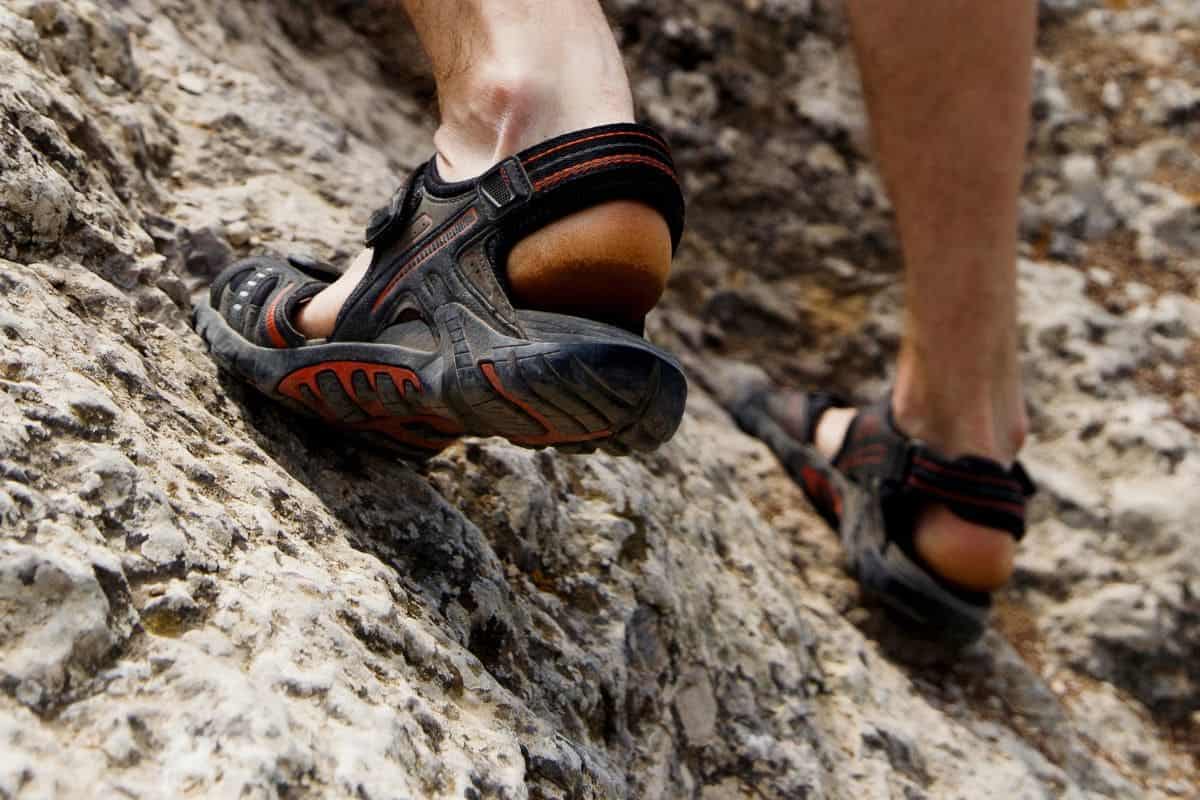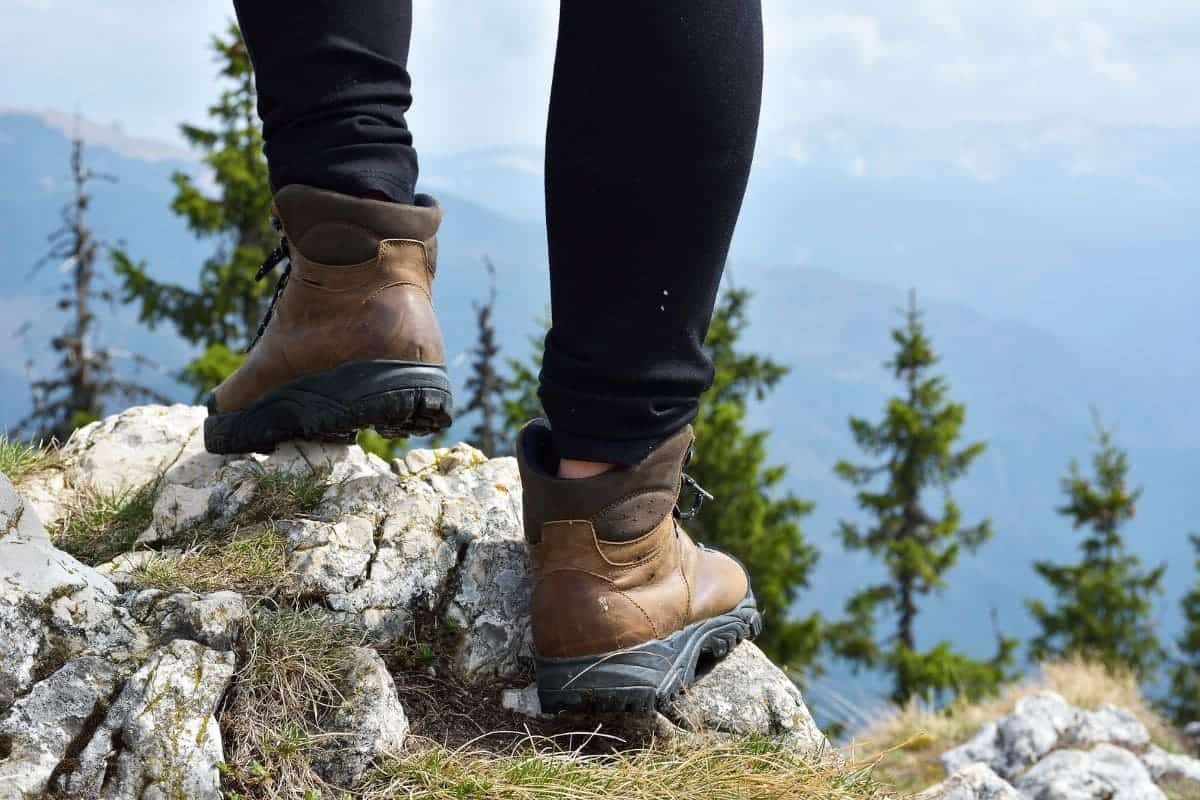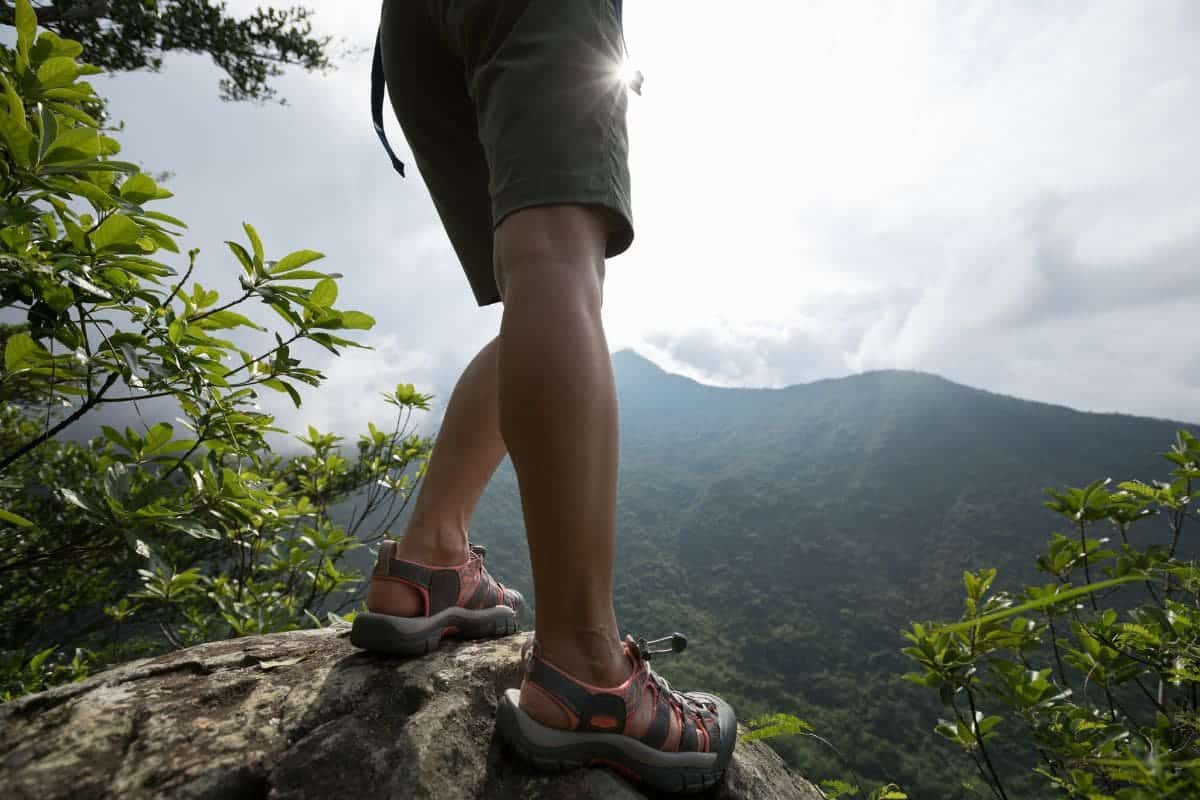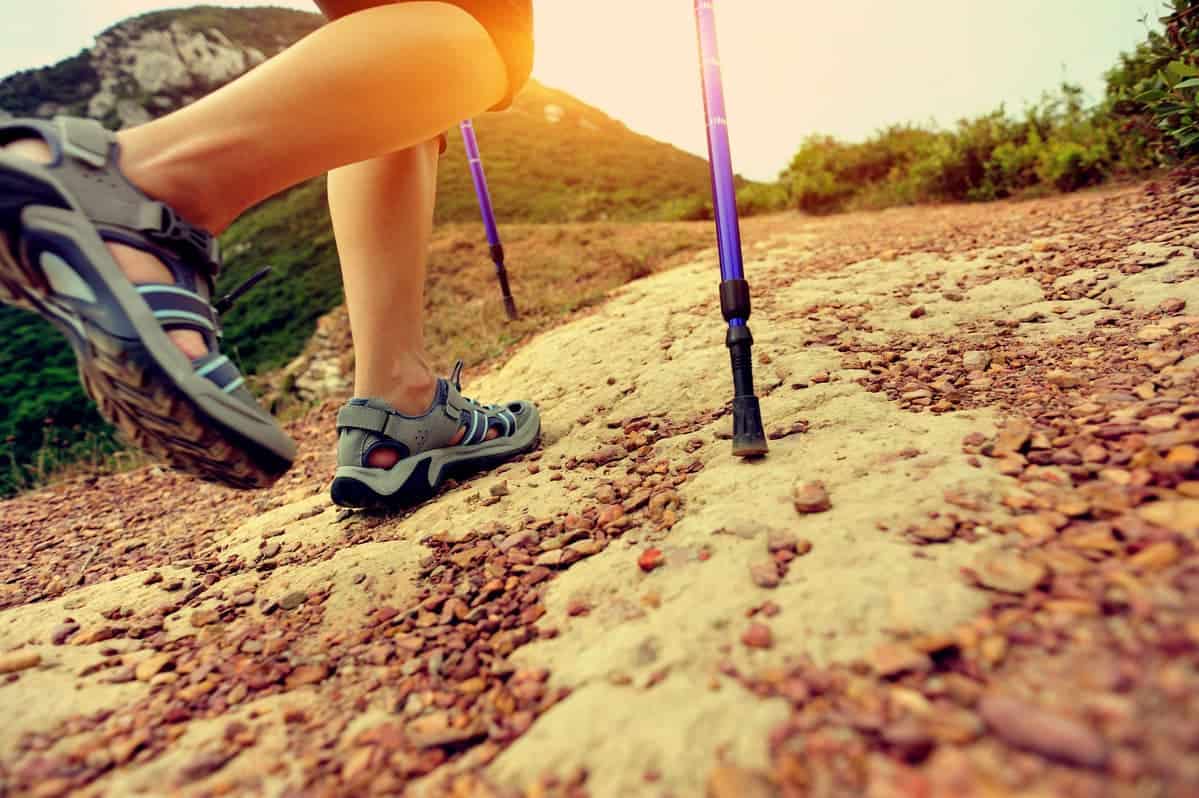Hiking sandals have become a popular choice among outdoor enthusiasts for their comfort and versatility. Which is great, but there are some things you’ll need to look out for. Is this footwear up to the task of handling rugged, uneven terrain?
In this article, we’ll go over the advantages and disadvantages of hiking sandals for the next time you hit the trail.
Key Takeaways:
- Hiking sandals can be a comfortable alternative to boots in hot weather.
- Quality varies by model, with some offering advanced features like rugged soles and arch support.
- While useful not only when you’re going on light hikes, these sandals require the right selection and maintenance.
Key Features of Hiking Sandals

When I hit the trails, the right pair of hiking sandals can make or break the experience. Here’s the rundown on what makes these sandals trail-ready.
Comfort and Support
The right hiking sandals offer an ergonomic footbed that cradles your feet and provides the support needed for long treks.
Look for adjustable straps; you’ll be sure to get a snug fit, minimizing the risk of blisters or discomfort.
Traction and Stability
On slippery or uneven terrain, the rubber outsole with multi-directional lugs gives the grip and stability necessary to stay upright. It’s important for safety and when you’re walking on the trail. You don’t want to be slipping all over the place.
Protection and Durability
How do you get durability? The same way you make anything else durable, from high-quality material. Sandles are no different. For them to last and not fall apart on you while on a hike, they need to be made well with good material.
Toe protection is a bonus to keep toes safe from rocks and roots, and a protective heel counter adds to the overall sturdiness.
Just because it’s a sandal doesn’t mean we’re going to leave our toes out to get beat up.
Weight and Versatility
I’m all about that lightweight feel that keeps me from being weighed down. The best hiking sandals are versatile enough for various activities from walking to a casual hangout post-hike.
Water Resistance and Breathability
For those inevitable water crossings or rainy days, quick-drying materials are a lifesaver. On top of that, good breathability keeps my feet from feeling swampy.
CoreM Pro-Tip: When gearing up for your next outdoor adventure, don’t just grab any pair of hiking sandals; consider the journey ahead. Keep in mind, the right sandal can turn a good hike into a great one, so match your footwear with the terrain and trek confidently into your next outdoor escapade!
Design Considerations

When picking out hiking sandals, I focus heavily on their construction and how they fit my feet. It’s not just about the look; it’s also about delivering the necessary support and comfort for the trails.
Material and Build
For a reliable hiking sandal, I pay attention to the following:
- Materials
- Construction
A rugged nylon shank offers great stability, especially on uneven terrain. The EVA footbed is a common choice because it provides both comfort and durability. For the straps, I look for a soft yet strong webbing that won’t fray or snap when I’m mid-adventure.
Foot Shape and Fit
Everyone’s foot is different, so adjustable straps are a game-changer for getting that perfect fit.
I avoid blisters by ensuring the sandal’s fit doesn’t allow for too much sliding around, particularly if there’s a heel strap or toe loop. A good fit is all about customization to my unique foot shape.
Aesthetics and Style
Hiking sandals come in various designs, from minimalist Y straps to more enclosed options. I consider the potential for tan lines when I’m chilling at the beach. The look is a personal choice, but I like mine to be versatile enough for multiple settings.
Closure Systems
Lastly, the closure system can make or break a hiking sandal in my experience. I’ve found that Velcro straps offer a quick and easy way to adjust the tightness, but they can wear out over time. Opt for hiking sandals equipped with a dependable buckle or bungee system.
Popular Hiking Sandal Models

When I hit the trails, I’m always on the lookout for reliable gear, and let’s face it, my feet deserve the best. Hiking sandals have evolved to offer great traction, comfort, and water-readiness.
Let’s check out some popular picks:
Keen Newport H2
My experience with the Keen Newport H2 has been a mix of durability and protection.
Keen Newport H2 is a closed-toe sandal which means no stubbed toes on rocky paths. These are often pegged as the best water sandals, excellent for river crossings.
With their beefy sole and quick-dry webbing, they really hold up to the name.
Chaco Z/Cloud Series
The Chaco Z/Cloud sandals distinguish themselves with fantastic arch support and the infamous adjustable strap system.
I find the Z/Cloud has a bit more cushioning than the classic version, making for a cloud-like trek. And there’s a reason the Z/1 Classic is named such—sturdy, reliable, and downright iconic.
Teva Series
Teva, like the Hurricane XLT2 and Terra Fi 5 Universal, are versatile. These are the best overall and best budget hiking sandal options.
Xero Shoes Models
The Xero Shoes Z-Trail EV sandals hit a sweet spot for those of us who prefer to feel lightweight yet supported. Some of its best features include:
- Trifecta of ultralight
- Sturdy
- Super packable
The Z-Trail EV, in particular, stands out for its flexibility, all the while offering just enough sole protection to handle diverse terrains.
Let’s summarize their best features:
| Sandal Model | Best Features |
|---|---|
| Keen Newport H2 | Closed-toe for protection, great for water, durable |
| Chaco Z/Cloud | Excellent arch support, adjustable strap, cushioned |
| Teva Hurricane XLT2 | Balance of performance, affordable |
| Teva Terra Fi 5 | Great for footbeds, rugged outsoles |
| Xero Shoes Z-Trail EV | Ultralight, sturdy, super packable, flexible |
Comparing Hiking Sandals With Other Footwear
Sandals vs Hiking Boots

Hiking boots offer superior ankle support and protection that’s hard to beat. You’re not going to get that from sandals, that’s just a plain fact. But on a hot day hike, I might swap them out for sandals to let my feet breathe.
The Teva Hurricane XLT2 sandals mentioned stand out as great for overall use, but don’t expect them to match the ruggedness of boots or get that ankle support.
CoreM Pro-Tip: For your camp shoes, choose lightweight sandals, such as the Luna Middle Bear. They provide a welcome break for your feet and offer comfort without the bulkiness of boots.
Sandals vs. Hiking Shoes
Hiking shoes are the middle ground, offering more flexibility than boots but more coverage than sandals. Really, people that hike a lot tend to have multiple pairs of hiking shoes, boots, and sandles.
I keep in mind though; trail sandals, like the Xero Z-Trail EV, provide an ultralight experience which is perfect for those quick jaunts through nature.
Sandals vs. Trail Runners
Trail runners are for speed on the trails and usually come with better arch support than regular sneakers. Now, trail sandals, are the bad boys offering similar breathability to trail runners, but with an open design.
Chaco Z Cloud 2
These are known for their arch support, which is a nice crossover between sandal comfort and the specific benefits of trail runners.
However, if you’re one to wear socks with your footwear, sandals might not be your go-to.
Use Cases for Hiking Sandals
When I’m considering trading in my hiking boots for sandals, I like to think about where and how I’ll be using them. Sandals can range from casual day use to handling the rigors of a multi-day backpacking trip.
Day Hikes and Casual Use
Sandals are a great choice for light day hikes and casual use, such as a trip to the beach or a short walk in the park. They offer breathability, which we talked about before. They’re ideal when you plan to be out for a few hours and don’t want your feet to overheat.
Plus, the quick on-and-off nature of sandals makes them perfect for those lazy days when you just want to lounge around the campsite.
- Breathability: Keeps feet cool on short, less demanding hikes.
- Ease: Quick to slip on for spontaneous outings and casual use.
Backpacking and Multi-Day Treks
For longer backpacking trips, I consider the type of sandals I’m packing.
Sturdier designs with thick soles and adjustable straps will be the best fit.
Some backpackers, including those tackling the loose rocks of the Appalachian Trail, find that quality hiking sandals with deep lugs and arch support can be a comfortable alternative to heavy boots.
However, I do consider pairing them with socks during colder weather or to prevent dirt from irritating my feet after a long day.
- Durability: Needed for withstanding multiple days on the trail.
- Support: Essential for carrying a heavier pack over varying terrain.
Water-Related Activities
Whenever water is involved, whether it’s water sports or just splashing through streams, I find water sandals a good go to. Their quick-drying capabilities make them suitable for amphibious adventures.
For years I used Crocks, but I like sandals more now.
I always opt for sandals that won’t slip off rocks easily and offer a good grip on slippery surfaces. This ensures that I can move from water to land and back again with ease.
- Quick-Drying: Prevents soggy feet after water activities.
- Grip: Provides stability on wet and slippery terrain.
Trail and Terrain Types
For well-maintained trails or sandy paths, sandals can be incredibly comfortable. But if I’m heading into areas with a large number of loose rocks or uneven terrain, I’ll look for sandals with a thicker sole and more aggressive tread to protect my feet.
Ultimately, the choice boils down to the trail conditions and my comfort and safety.
- Thick Soles: Offer protection against sharp rocks and rough ground.
- Tread: Helps with traction on varied terrain types, from flat dirt to rocky inclines.
Caring for Your Hiking Sandals

I’ve come to realize that if I take good care of my hiking sandals, they last a whole lot longer and stay comfortable every step of the way. This is basically how I look at all my mountaineering gear. Take care of your stuff, and it will take care of you!
Here’s how I keep my trusty sandals in top shape for all my adventures.
Maintaining and Cleaning
I make sure to routinely clean my sandals to maintain their durability and quick-drying attributes. I suggest soaking your sandals face down in a bucket filled with soapy water for 30 minutes. It’s also important not to overlook the footbed, which can have bacteria and odor.
After washing
- Rinse thoroughly with clean water.
- Air dry away from direct heat or sunlight. Just keep them out on your tile or deck.
Dealing With Wear and Tear
When I spot signs of wear, I tackle them immediately. You got to!
For minor damage, like loose threads or small detachers, I use a strong adhesive designed for fabrics and rubber. I always keep a repair kit handy for any quick fixes while on the trail.
Common Repair Kit Items:
- Fabric glue
- Sewing kit
- Replacement buckles or straps
Proper Storage
Storing my hiking sandals correctly plays a crucial role in prolonging my life. I avoid leaving them outdoors as prolonged exposure to sun or rain can degrade the materials.
I also store my sandals in a cool, dry place, and I make sure they’re completely dry before tucking them away.
Storage Tips
- Don’t put them in airtight containers; circulation is key.
- If dampness is an issue, I use silica gel packs to absorb moisture.
Frequently Asked Questions
What are the benefits of wearing hiking sandals versus traditional hiking boots?
When I choose sandals over boots, I get more breathability and less weight, which is great on a hot day. They also dry out faster if I have to cross a stream.
Can hiking sandals provide enough support for beginners on the trail?
Absolutely, but it depends on the sandal. Beginners should look for options with good arch support and adjustable straps for a secure fit.
How suitable are hiking sandals for various terrains, like beaches or rocky paths?
Sandals excel on beaches where you can enjoy the sand without it filling up your footwear. On rocky paths, you can opt for sandals with a thicker sole and toe protection.
What should one look for in a hiking sandal to ensure sufficient arch support?
You should peek at the midsole construction, look for sturdy, contouring materials like EVA, and make sure the arch area is well-defined before you buy.
Are there closed-toe hiking sandals that offer toe protection similar to shoes?
Yep, brands like Keen have closed-toe hiking sandals that provide a shoe-like buffer for my toes while keeping the rest of my foot cool and free.
How do men’s and women’s hiking sandals differ in terms of design and fit?
Typically, women’s sandals have a narrower fit, while men’s are wider. Some brands also tweak the arch support and strap positioning to better suit the gender-specific foot shape.
Final Thoughts – Choose The Right Sandals That Aligns Your Specific Trail Requirements
Hiking sandals represent a versatile and practical choice for many outdoor adventurers. If arch support and adjustability are key, the Chaco Z/Cloud is a superb choice. Budget-conscious hikers seeking balanced performance may lean towards the Teva Hurricane XLT2, while those looking for excellent footbeds and rugged outsoles might prefer the Teva Terra Fi 5. For adventurers valuing an ultralight, packable, and flexible option, the Xero Shoes Z-Trail EV shines.
Ultimately, the best hiking sandal is one that aligns with your specific trail requirements, comfort preferences, and activity types, ensuring an enjoyable outdoor experience.







